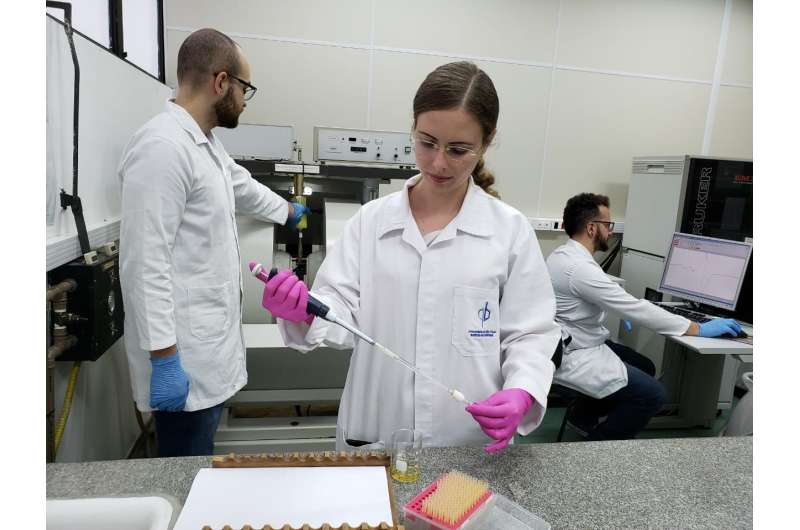Researchers discover a link between two important products of nitric oxide

Ever since three U.S.-based researchers working independently unveiled the role of nitric oxide in mediating blood vessel dilation, endothelial cell contraction and smooth muscle relaxation, their discoveries have served as a basis for novel treatments for high blood pressure and erectile dysfunction, among other conditions.
The Nobel Prize in Physiology or Medicine in 1998 was awarded jointly to Robert F. Furchgott, Louis J. Ignarro and Ferid Murad for groundbreaking research of nitric oxide conducted during the 1970s and 1980s. Their work paved the way for the development of redox biochemistry, an entirely new research field. Nitric oxide is a free radical that has been shown to play a key role in the body's defenses against tumors and bacteria, as well as in inflammatory and wound healing processes.
Like any biological molecule, nitric oxide is modified in organisms, and the resulting products also act on the body. Understanding how these products are formed in cells is important to the development of new medications designed to increase or decrease the effects of nitric oxide, depending on the condition that is to be treated.
In contrast with the prevailing belief before the discoveries made by Furchgott, Ignarro and Murad, free radicals such as nitric oxide are not necessarily toxic to cells. They are vital for the molecular signaling that maintains cellular homeostasis and are hazardous only at high concentrations.
In an article published in the journal Chemical Communications, scientists have revealed a hitherto unknown mechanism underlying the formation of nitroso thiols, which are important reaction products of nitric oxide. The group—comprising two researchers affiliated with the University of São Paulo Chemistry Institute (IQ-USP) in Brazil and a colleague at the University of California Santa Barbara (UCSB) in the US—found that this process occurs during the formation of dinitrosyl iron complexes (DNICs), which are also products of nitric oxide.
In previous research, whenever nitroso thiols and DNICs appeared together in experiments in cells, DNICs were thought to donate nitric oxide to thiols to convert them into nitroso thiols.
The group showed that the mechanism whereby DNICs are formed gives rise to thiyl radicals. Because these are also free radicals, they react with nitric oxide, and this reaction produces nitroso thiols.
"DNICS have been tested for several functions because they promote similar actions to nitric oxide. The issue is that DNICs are currently tested by trial and error, due to the lack of sufficient information to select those best suited for each desired biological action. Our research involves studying the characteristics of the different DNICs to determine which are most reactive, so that we can then model a specific complex, for example, as the basis for developing a vasodilatory or wound healing drug," said Daniela Ramos Truzzi, a professor at IQ-USP and the first author of the article. The study was part of her postdoctoral research at IQ-USP.
DNICs
Many complexes that are derived from nitric oxide are produced in cells, but DNICs are the most abundant. Their physiological roles include protein S-nitrosation (or nitrosylation), which is a post-translational modification during which nitric oxide attacks specific cysteine residues in proteins, forming S-nitroso thiol groups. S-nitrosation is a key mechanism for the regulation of various protein classes and influences many physiological processes.
The researchers could not determine exactly which compounds are derived from which reactions because of the intensity of intracellular activity, so they chose experimental parameters that were as close as possible to physiological conditions, while knowing in advance which elements were present.
They used electron paramagnetic resonance (EPR) to observe the reaction between iron II (ferrous) oxide, nitric oxide, and the low-molecular-weight thiols cysteine and glutathione. All are abundant in mammalian cells.
"The final compounds, in this case the DNICs, appeared after only a second. They form very rapidly," Truzzi explained. "We then started to study how these molecules bind and managed to determine the mechanisms of formation. To our surprise, we found that thiyl radicals were also produced along with DNICs."
Radicals often react with each other, and thiyl radicals naturally react with nitric oxide. This reaction produced nitroso thiols.
"Nitroso thiols may be involved in cell signaling," he said. "In addition, high levels of nitroso thiols have been found to be correlated with the development of neurodegenerative diseases and cancer."
New studies will be performed with other thiols to see if the effect recurs and to confirm the discovery.
"REDOXOME focuses on metabolic and cardiovascular diseases, but it is important to understand the mechanistic details in order to be able to intervene in the processes of interest, and that is our main research aim in this instance," Augusto said.
More information: Daniela R. Truzzi et al, Thiyl radicals are co-products of dinitrosyl iron complex (DNIC) formation, Chemical Communications (2019). DOI: 10.1039/C9CC04454J
Journal information: Chemical Communications
Provided by FAPESP



















